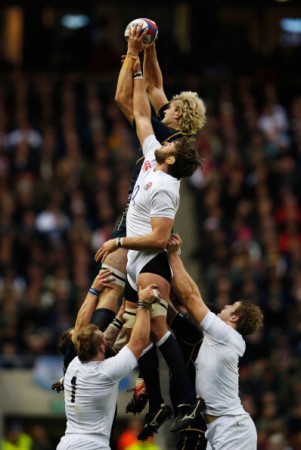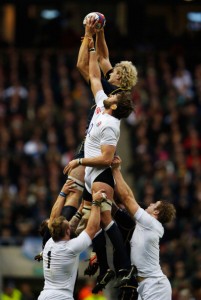By Alex Lowe
ENGLAND RETAINED the Calcutta Cup and launched their Six Nations campaign with a 38-18 victory over Scotland at Twickenham, their biggest win in the fixture for six years. Here’s how…
Possession is the law
England’s analysis of international rugby had told them that the majority of Test matches in 2012 were won by the team with the least possession. Not on Saturday.
England wore Scotland down by bossing both territory (68.5%) and possession (62%) at Twickenham. From the moment Ben Morgan charged upfield in the opening seconds, bouncing Sean Maitland off, England’s ball-carriers had Scotland on the back foot.
With Owen Farrell in imperious form behind dominant forwards who were securing quick ball, Scotland never got a foothold in the game.
Even when Maitland had given Scotland a surprise lead, England simply marched back downfield and Farrell landed two penalties in quick succession, both earned at the breakdown, to regain control.
Pass and move, it’s the England groove
One year into Stuart Lancaster’s regime and England are looking to move their game on. They want to play at pace, to keep opposing defences in a permanent state of disorganisation and they achieved it with the forwards offloading and passing before contact. England made a staggering 194 passes and 19 offloads, a “risk-reward” tactic that kept the momentum up and meant Scotland were always scrambling, something they actually did well considering the weight of pressure on them.
That game plan relies on good handling skills, which is where Mike Catt’s influence has been important.
Lion in waiting
And with that momentum, England had Farrell in the general’s seat silencing a few critics. There are those who feel he is a one-dimensional fly-half, a product of his Saracens upbringing. But Farrell played flat and with a wider screen vision than in any of his previous England appearances. His pass for Geoff Parling’s try was a thing of beauty.
Johnny Sexton may play with a more natural élan but Farrell is unflappable. He is ferocious in defence, he boasts a fierce competitive streak and he can play a bit too.
Farrell should be the British & Irish Lions Test fly-half this summer.
Midfield headache
Key to Farrell’s approach to the game was the presence outside him of Billy Twelvetrees, who enjoyed an eye-catching debut. It was not long before early comparisons with the Jonny Wilkinson-Will Greenwood axis were being made. Early days, early days. But there is a definite potential for a special partnership to build.
Twelvetrees is tall and physical, he’s a strong ball-carrier with a fly-half’s view of the game.
The question for Lancaster is whether he can risk heading to Ireland without Brad Barritt anchoring the defence at inside-centre. Manu Tuilagi is fit again and should start at 13. Twelvetrees is on a different level to Barritt with the ball in hand but the Saracen runs England’s defence. I say be bold. Farrell-Twelvetrees-Tuilagi will ask questions of the Irish midfield.
Turnover trouble
Where England must improve is in their defence from turnover ball. Scotland punished them twice on Saturday, with tries from Maitland and Stuart Hogg, who was impressive for the visitors. Ireland will be a far more dangerous attacking prospect. There were a few lineout wobbles, too, which Parling will be slavishly ironing out this week.
To be looking to improve from a winning position, in the wake of a solid, satisfying first performance of the championship is just where Lancaster would want to be.
Follow Alex Lowe on Twitter @AlexMLowe








